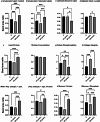FTIR spectroscopic characterization reveals short-term macromolecular responses to photobiomodulation in mesenchymal stem cells
- PMID: 40849501
- PMCID: PMC12375009
- DOI: 10.1038/s41598-025-15190-7
FTIR spectroscopic characterization reveals short-term macromolecular responses to photobiomodulation in mesenchymal stem cells
Abstract
Photobiomodulation (low-level laser therapy) was reported to promote tissue repair, stem cell differentiation and proliferation; however, the underlying cellular mechanisms remain unclear. Investigating early, subtle cellular responses may be the key to optimize therapeutic outcomes and understand the biological effects of photobiomodulation. This study aimed to assess short-term macromolecular alterations in adipose-derived mesenchymal stem cells (ADSCs) subjected to 671 nm low-level laser irradiation via Fourier transform infrared (FTIR) spectroscopy. ADSCs were divided into control, 1-hour (1 H post-L) and 3-hour (3 H post-L) post-irradiation groups. 671 nm low-level laser irradiation was applied at a fluency of 25 J/cm2. After 1 and 3 h, cells were collected and placed on the ATR unit of the FTIR spectrophotometer, dried under mild nitrogen flow and analyzed. Photobiomodulation resulted in explicit differences in FTIR spectra of 1 H and 3 H post-L groups, including alterations in lipid composition, protein secondary structure, protein phosphorylation together with changes in metabolic turnover of carbohydrates over time. Additionally, the membrane order decreased and fluidity increased in the 1 H post-L group, suggesting a temporary lateral phase separation in ADSC membranes. Photobiomodulation induced short-term structural and compositional alterations in biomolecules of ADSCs, which is further remarkable to provide insights into its action mechanism.
Keywords: Adipose-derived mesenchymal stem cells; FTIR spectroscopy; Low-level laser therapy; Photobiomodulation; Short-term effects.
© 2025. The Author(s).
Conflict of interest statement
Declarations. Competing interests: The authors declare no competing interests.
Figures




Similar articles
-
The impact of photobiomodulation therapy on the survival and differentiation of periodontal ligament mesenchymal stem cells exposed to zoledronic acid.Sci Rep. 2025 Aug 28;15(1):31731. doi: 10.1038/s41598-025-17466-4. Sci Rep. 2025. PMID: 40877474 Free PMC article.
-
Boosting osteoblast differentiation: enhancing the effects of low-level blue laser therapy on human embryonic stem cell-derived mesenchymal stem cells to improve viability and calcium deposition.Lasers Med Sci. 2025 Jul 22;40(1):323. doi: 10.1007/s10103-025-04564-y. Lasers Med Sci. 2025. PMID: 40694189 Free PMC article.
-
Biological characteristics of tissue engineered-nerve grafts enhancing peripheral nerve regeneration.Stem Cell Res Ther. 2024 Jul 18;15(1):215. doi: 10.1186/s13287-024-03827-9. Stem Cell Res Ther. 2024. PMID: 39020413 Free PMC article.
-
Management of urinary stones by experts in stone disease (ESD 2025).Arch Ital Urol Androl. 2025 Jun 30;97(2):14085. doi: 10.4081/aiua.2025.14085. Epub 2025 Jun 30. Arch Ital Urol Androl. 2025. PMID: 40583613 Review.
-
Priming effect of photobiomodulation of mesenchymal stem cells on extracellular vesicles for regenerative medicine.Mol Biol Rep. 2025 Jul 12;52(1):707. doi: 10.1007/s11033-025-10791-x. Mol Biol Rep. 2025. PMID: 40650674 Review.
References
-
- Atala, A. Advances in tissue and organ replacement. Curr. Stem Cell. Res. Ther.3 (1), 21–31 (2008). - PubMed
-
- Chang, S. Y., Carpena, N. T., Kang, B. J. & Lee, M. Y. Effects of photobiomodulation on stem cells important for regenerative medicine. Med. Lasers. 9 (2), 134–141 (2020).
-
- AlGhamdi, K. M., Kumar, A. & Moussa, N. A. Low-level laser therapy: a useful technique for enhancing the proliferation of various cultured cells. Lasers Med. Sci.27 (1), 237–249 (2012). - PubMed
MeSH terms
Grants and funding
LinkOut - more resources
Full Text Sources
Miscellaneous

